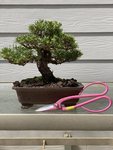ProfessorFarnsworth
Mame
Decandling timing is something of a dark art! Lol!! Everyone has to figure out what works for them in their particular micro climate, their trees, Their repotting frequency, their watering practices, their fertilization, their sun exposure, temperatures, etc. Many, many factors enter in to it.
I think the moment things started to click for me was when I started to realize that there is no instruction manual that you can just follow. That took me a bit because that's just not how life works now "everything has a manual and generally a right way to do it!" Full sun might not mean full sun when it's 105° was my first lesson on this.



